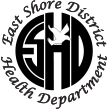Food Establishment Storm Protocol
IN THE EVENT OF A POWER OUTAGE THAT LASTS FOR MORE THAN 4 HOURS All food ESTABLISHMENTS ARE RESPONSIBLE TO CLOSE UNLESS PRIOR ARRANGEMENTS HAVE BEEN MADE (IE.. USE OF A GENERATOR)
You must also close your food service facility if flooded conditions occur and/or have a loss of water for an extended period of four (4) hours or more.
You must contact the ESDHD for an inspection before reopening!
Food Safety Center: Food Businesses
Food Safety During Power Outages in Food Establishments
The following are recommendations that apply to food safety during an extended power outage (more than two hours). Appropriate decision making before, during, and immediately after a power outage is necessary to protect consumers from unsafe food and minimize product loss. The Department recommends that food establishments develop a power outage plan before the need arises.
On this page:
When there is a Power Outage
Potentially Hazardous Foods
Keep Foods at Safe Temperatures
Freezers
Refrigerators
What to Discard
When Power is Restored
When there is a Power Outage
- Note the time the power outage begins.
- Discontinue all cooking operations.
- Do not place hot food in refrigerators or freezers, as this will rapidly raise the temperature inside the refrigerator or freezer and may make more food unusable.
- Discard food products that are in the process of being cooked, but which have not yet reached the final cooking temperature.
- Maintain hot potentially hazardous food at 135°F or above. Food that has reached final cooking temperature may be kept hot (135°F) by use of canned heat in chafing dishes.
- Use ice or/ice baths to rapidly cool small batches of hot food.
Check with your local Fire Department and Building Department before using any generators.
Food Safety
Potentially Hazardous Foods
Potentially hazardous foods are those foods such as high protein foods (meat, eggs, dairy) and cooked vegetables that support the rapid and progressive growth of disease causing bacteria.
Foodborne illnesses can be caused by bacteria that can multiply rapidly in foods when the food is held in the temperature danger zone (41° to 135°F).
Keep foods at safe temperatures
Refrigerated potentially hazardous foods must be stored at or below 41°F. Frozen foods must be maintained frozen. Hot cooked potentially hazardous food must be maintained at 135°F or above.
Freezers
Leave the freezer door closed. A full freezer should keep food safe about two days -- a half-full freezer, about one day. Add bags of ice or dry ice to the freezer if it appears the power will be off for an extended time. You can safely re-freeze thawed foods that still contain ice crystals and are 41°F or less.
Caution: the use of dry ice may result in the unsafe build-up of carbon dioxide.
Refrigerators
Food in refrigerators should be safe as long as the power is out no more than about four hours. Leave the door closed; every time you open it, needed cold air escapes, causing the foods inside to reach unsafe temperatures. Discard any potentially hazardous food after 4 hours if power is not restored or alternate cooling methods have not been implemented within 2 hours. Discard food that has an unusual color, odor, or texture.
When in doubt, throw it out!
If it appears the power will be off for more than six hours, ice, dry ice, or frozen gel packs can be used to keep potentially hazardous foods at 41° or below. Moving refrigerated food to a walk-in freezer or obtaining a refrigerated truck are other options to keep food safe. Food should not be transferred to private homes.
What to Discard
Discard
The following foods in refrigerators and freezers should be discarded if kept over four hours at above 41°F.
- Meat, poultry, fish, eggs and egg substitutes - raw or cooked
- Milk, cream and soft cheese
- Casseroles, stews or soups
- Lunch meats and hot dogs
- Creamy-based foods made on-site
- Custard, chiffon, pumpkin or cheese pies
- Cream-filled pastries
- Cookie dough made with eggs
- Whipped Butter
- Cut melons and tomatoes
- Cooked vegetables, pasta, rice
Save
The following foods may be kept at room temperature a few days although food quality may be affected.
- Hard and processed cheeses
- Fresh uncut fruits and vegetables (except for sprouts)
- Dried fruits and coconut
- Opened jars of vinegar-based salad dressings, jelly, relish, taco sauce, barbecue sauce, mustard, ketchup, olives and peanut butter
- Fruit juices
- Fresh herbs and spices
- Fruit pies, breads, rolls, and muffins
- Cakes, except cream cheese frosted or cream-filled
- Flour and nuts
When Power is Restored
- Identify and discard potentially hazardous foods that may have been above 41°F or below 135°F for four or more hours or above 41°F for any length of time.
- Check the internal food temperatures using a food thermometer and record the temperature.
- If practical, separate packages of food in refrigeration units and freezers to allow for faster re-cooling.
- Rapidly cool refrigerated foods in a freezer until the temperature goes below 41°F.
-
Defrost cycles will be off-set. Please remember to reset your timers for the defrost cycles of your coolers and freezers!
East Shore District Health Department (ESDHD)
688 East Main St.
Branford, CT 06405
Phone: 203-481-4233
FAX: 203-483-6894
info@esdhd.org
Website: www.esdhd.org
